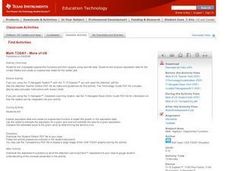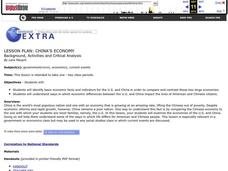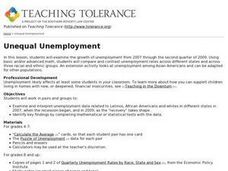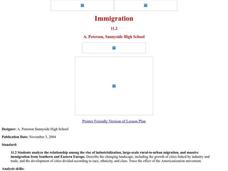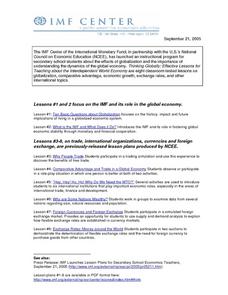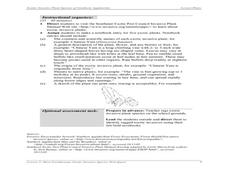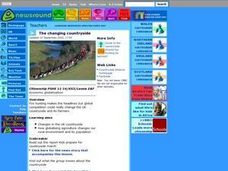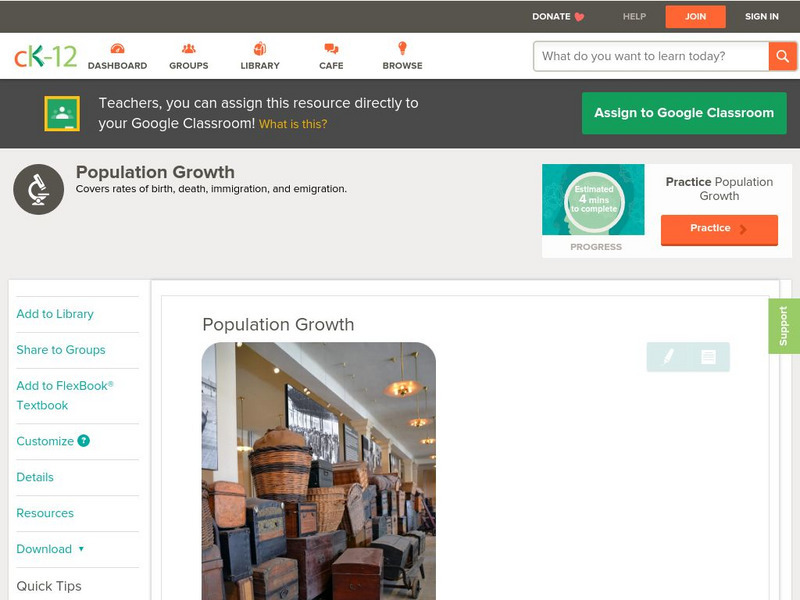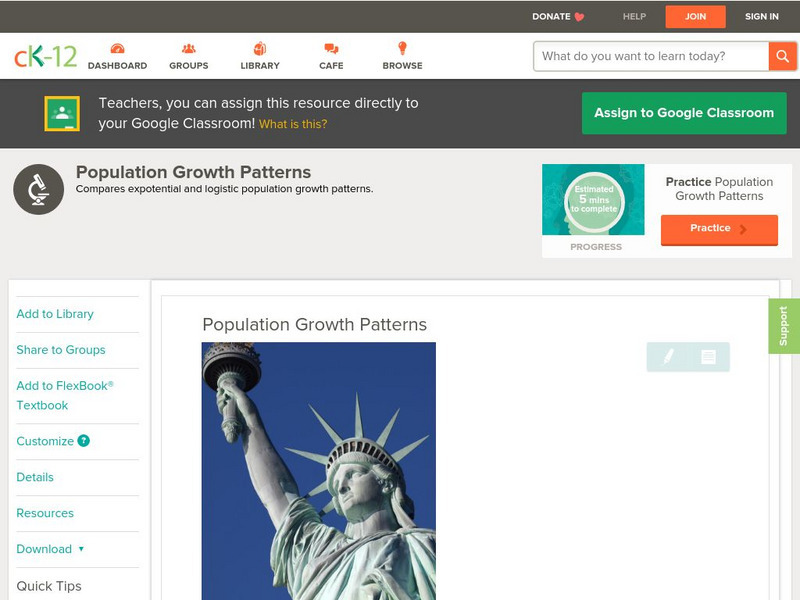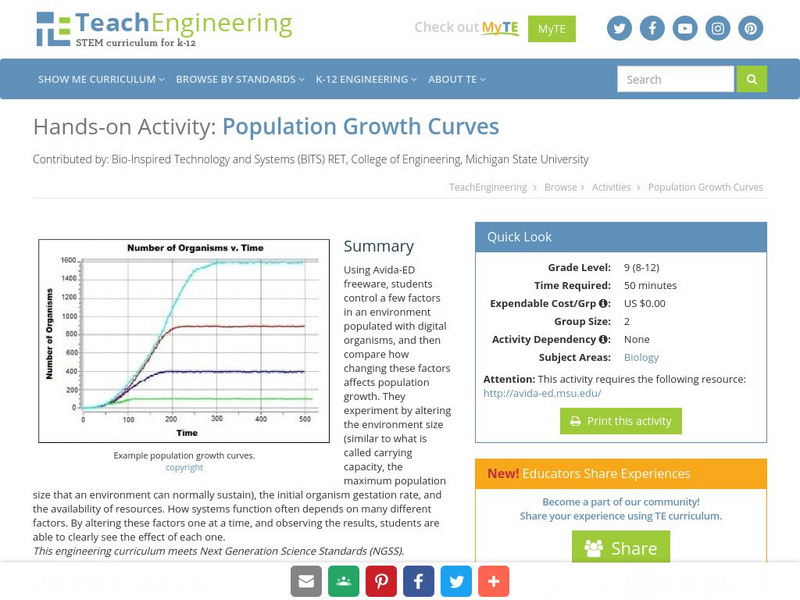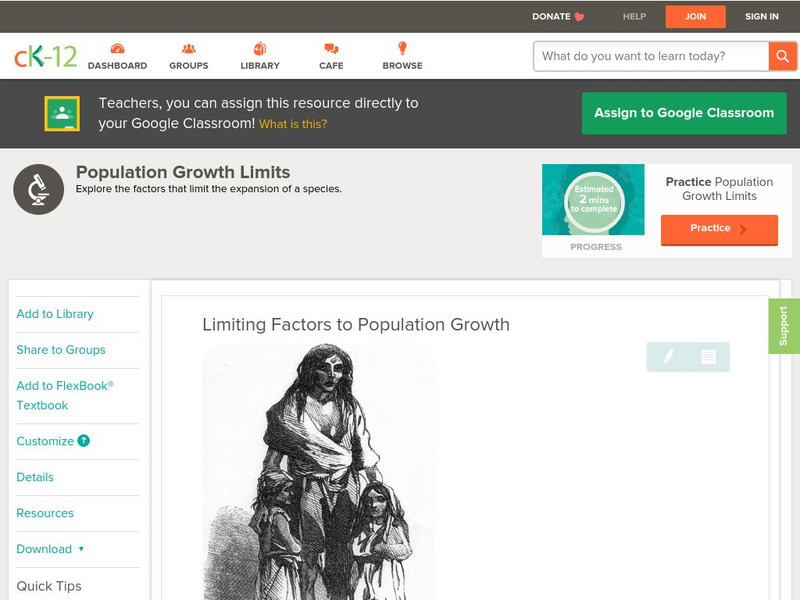Curated OER
More of U.S.
Explore graphical representation of a real-life data set and determine the exponential regression model for the data in your classroom. High schoolers also compare the estimated value to the given value by determining the percent error.
Curated OER
What's The Plan?
High schoolers identify how the human activities in the state of Maryland have changed/ evolved over the last 50 years. They evaluate a land planning document and prepare a fictitious planning document for a given area of land.
Curated OER
China's Economy
Twelfth graders identify indicators for the U.S. and China in order to compare and contrast these two large economies. They explain ways in which economic differences between the U.S. and China impact the lives of American and Chinese...
Curated OER
Unequal Unemployment
Young scholars examine unemployment in the United States. In this statistics lesson, students examine data and primary sources regarding unemployment in the United States.
Curated OER
China's Economy
Students examine China's economy. In this economics lesson, students investigate economic facts and indicators for the U.S. and China in order to compare and contrast these two large economies.
Curated OER
Cranes, Crosswalks, and Big Gulps
Students watch a video and answer questions based on wildlife jobs. In this wildlife lesson plan, students learn that biologists don't just play with animals but that there is a lot of study involved.
Curated OER
Immigration
Students explore the concept of immigration. In this immigration instructional activity, students read literature, analyze photographs, and evaluate political cartoons that reflect feelings about immigration in America during...
Curated OER
Algae Experiments
Students describe the characteristics of algae. In this biology lesson, students perform a series of experiment to explore algae. They investigate the basic things algae need to survive.
Curated OER
Hey, Hey! Ho, Ho! Why Do We Need the WTO?
Learners participate in various hand-on activities as they study six international institutions that play important economic roles in the areas of international trade and finance.
Curated OER
Traveling for Water
Students explore global water contamination and water shortage problems. In this geography/ecology lesson plan, students gain information about the lack of safe drinking water in many countries. Students read, use websites, and complete...
Curated OER
Most Troublesome Exotic Invasive Plant Species Web Quest
Students participate in a Web Quest activity in which they identify common exotic invasive plant species of the Southern Appalachian Region. After identifying the top 10 exotic invasive species, they choose one to research in depth.
Curated OER
International Monetary Fund
Twelfth graders discover the role of the International Monetary Fund. They use the internet to answer questions about the organization. They discuss the positive and negatives associated with the IMF.
Curated OER
The Changing countryside
Pupils draw a poster showing the costs and benefits of opening up Britain's farmers to the global marketplace. They use a piece of A4 or A3 paper in landscape. Students draw a vertical line to split the page in two. On the left place...
Curated OER
International Monetary Fund
Twelfth graders examine the role of the International Monetary Fund. They participate in activities to discover the funtion of the organization. They also focus on fair trade and cooperation between its members.
CK-12 Foundation
Ck 12: Biology: Population Growth
[Free Registration/Login may be required to access all resource tools.] Describes how rates of birth, death, immigration, and emigration affect population growth.
Scholastic
Scholastic: Study Jams! Science: Ecosystems: Population Growth
Population in areas is most often determined by environmental factors. This video and the test will help ensure understanding of the trends of population growth with scientific evidence.
National Humanities Center
National Humanities Center: Teacher Serve: Choosing Future Population
Essay on population growth past, present and future and the impact on society. Includes guiding questions for students and links to related resources.
CK-12 Foundation
Ck 12: Life Science: Population Growth Patterns
[Free Registration/Login may be required to access all resource tools.] What does population growth mean? You can probably guess that it means the number of individuals in a population is increasing. The population growth rate tells you...
Center for Innovation in Engineering and Science Education, Stevens Institute of Technology
Ciese: Population Growth Project
In this collection of nine lessons, students use data from the U.S. Census to create population growth models and to examine the impact of changes in population factors such as age, demographic, etc.
TeachEngineering
Teach Engineering: Population Growth Curves
Using Avida-ED freeware, students control a few factors in an environment populated with digital organisms, and then compare how changing these factors affects population growth. They experiment by altering the environment size (similar...
CK-12 Foundation
Ck 12: Earth Science: Future Human Population Growth
[Free Registration/Login may be required to access all resource tools.] Describes future population growth.
Science Buddies
Science Buddies: Project Ideas: Crystal Ball Math: Predicting Population Growth
In this environmental science fair project, students will learn some of the ways in which the population growth of animals is modeled, and then use the logistic model to determine how a population grows when it starts far below, at, or...
CK-12 Foundation
Ck 12: Life Science: Limiting Factors to Population Growth
[Free Registration/Login may be required to access all resource tools.] For a population to be healthy, factors such as food, nutrients, water and space, must be available. Limiting factors are resources or other factors in the...
Khan Academy
Khan Academy: Activity: Population Growth
In this activity, you will study and analyze the nature and patterns of human population growth over the last 10,000 years. This will help you understand the differences between population growth before and after the Modern Revolution.
